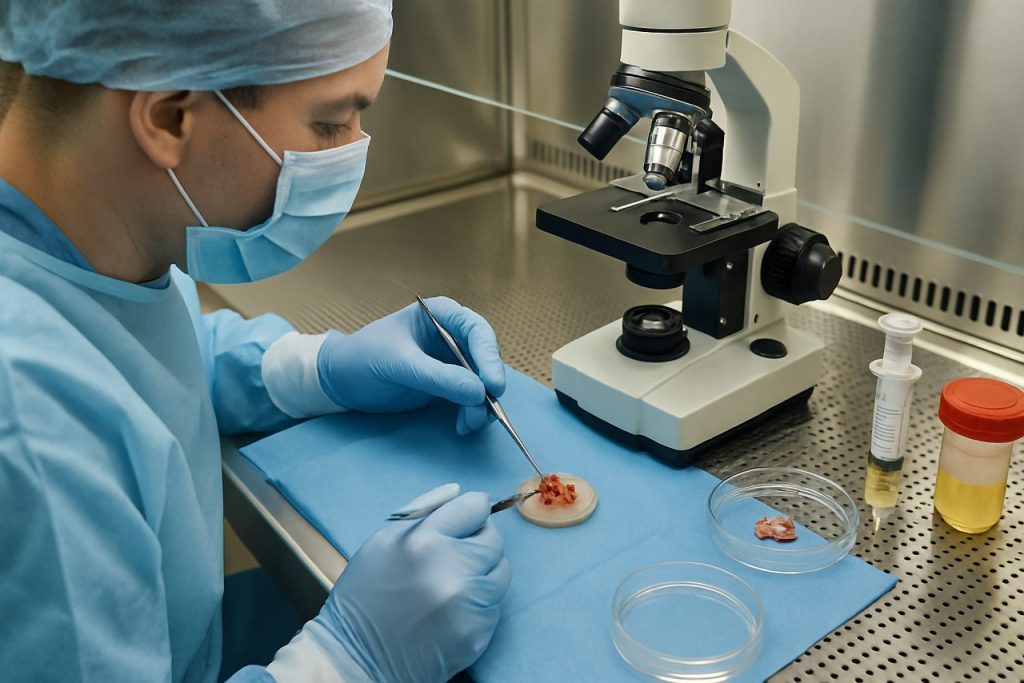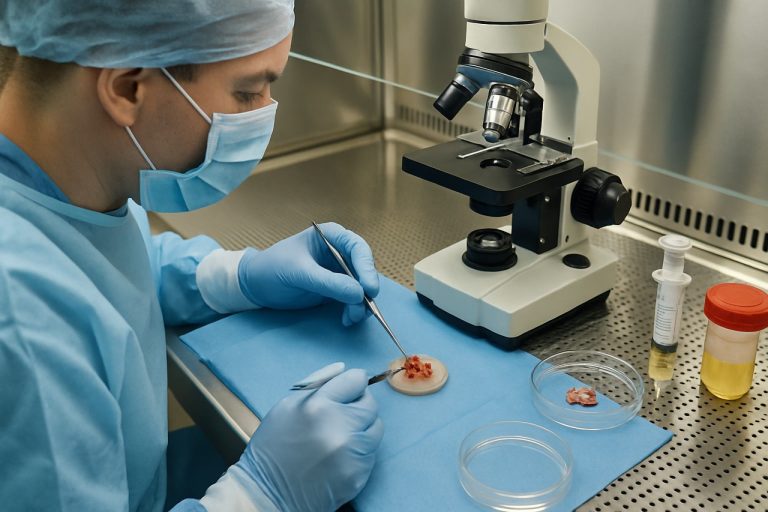
Table of Contents
- Executive Summary: Unveiling the 2025 Market Landscape
- Key Industry Players and Official Innovations
- Emerging Technologies Transforming Grafting Manufacturing
- Global Market Size and 5-Year Growth Forecasts
- Regulatory Shifts and Standards Impacting Production
- Supply Chain & Manufacturing Process Optimization
- Competitive Analysis: Strategies of Leading Manufacturers
- Investment Hotspots and Partnership Trends
- Regional Opportunities: North America, Europe, Asia-Pacific
- Future Outlook: Disruptive Trends and Next-Gen Applications
- Sources & References
Executive Summary: Unveiling the 2025 Market Landscape
The global landscape for microsegmental cartilage grafting manufacturing in 2025 is characterized by rapid technological advancements, increased clinical adoption, and strategic industry partnerships. Microsegmental cartilage grafting, a minimally invasive approach for repairing articular cartilage defects, is gaining traction due to its potential to improve patient outcomes, reduce recovery times, and address limitations associated with traditional cartilage repair methods.
A notable driver in 2025 is the ongoing shift from purely autologous chondrocyte implantation (ACI) to next-generation grafting solutions that leverage segmented, pre-formed cartilage matrices. Leading orthopedic and regenerative medicine companies are scaling up manufacturing capabilities to meet the rising demand. For instance, Arthrex continues to expand its biologics portfolio, with dedicated infrastructure for cartilage repair technologies, including microfragmented and microsegmental grafts. Similarly, Orthofix is investing in advanced tissue processing and sterilization techniques to ensure graft safety and efficacy.
In 2025, manufacturing innovations are centered on precision segmentation, automated microfabrication, and enhanced quality control. Companies such as Azzur Group are collaborating with device manufacturers to refine Good Manufacturing Practice (GMP) protocols specific to small-volume, high-value cartilage grafts. Automation and digital tracking are reducing batch variability and ensuring traceability—a growing regulatory requirement in both the U.S. and Europe.
The regulatory landscape is also evolving. The U.S. Food and Drug Administration (FDA) continues to update its guidance for human tissue-based products, while the European Medicines Agency (EMA) is streamlining the Advanced Therapy Medicinal Products (ATMP) pathway, supporting faster clinical translation for novel cartilage grafts. Companies are responding by integrating regulatory feedback earlier in the development and manufacturing process, ensuring compliance and market readiness.
Looking ahead, the microsegmental cartilage grafting manufacturing sector is poised for continued expansion through 2025 and beyond. Key growth factors include the increasing prevalence of osteoarthritis and sports injuries, the aging global population, and ongoing R&D collaborations between industry and academic centers. Strategic investments in scalable, GMP-compliant manufacturing, alongside robust post-market surveillance, are expected to accelerate clinical adoption and broaden patient access worldwide.
Key Industry Players and Official Innovations
Microsegmental cartilage grafting manufacturing has emerged as a focal point in regenerative orthopedics, with a growing cohort of industry leaders driving innovation and commercialization. As of 2025, several manufacturers and biotechnology companies are actively scaling up production capacity, refining automation, and introducing novel platforms for precise cartilage repair and transplantation.
Prominent among these is Arthrex, Inc., which has developed a series of advanced instruments and kits designed to harvest and deliver cartilage micrografts with minimal donor site morbidity. Their GraftNet and Arthrex Cartilage Allograft systems are currently being utilized in both clinical trials and commercial surgical settings, emphasizing single-step, minimally invasive techniques for cartilage defect repair.
Another pivotal player, Vericel Corporation, continues to advance its manufacturing processes for autologous and allogeneic cartilage cell therapies. Their MACI® product, an FDA-approved autologous cultured chondrocyte implant, has catalyzed further R&D toward microfragmented and segmental graft formats designed for enhanced integration and streamlined manufacturing workflows.
In Europe, TETEC AG is notable for its expansion of GMP-certified facilities to support scale-up and customization of cell-based cartilage repair products. In 2025, TETEC is piloting semi-automated platforms for microsegmental graft production, aiming to reduce lead times and improve batch-to-batch consistency.
Meanwhile, Ziemer Group AG has entered the segment with next-generation tissue processing tools, targeting greater precision in the preparation of microcartilage segments. Their systems integrate with digital planning software, facilitating personalized graft geometries and documentation—an approach that aligns with evolving regulatory expectations for traceability and quality control.
Looking ahead, industry outlook points to continued investment in automation, robotics, and closed-system bioprocessing to meet rising clinical demand and regulatory scrutiny. Partnerships between device manufacturers and tissue banks are expected to increase, as seen in ongoing collaborations between Arthrex, Inc. and leading US tissue suppliers. Efforts are also underway to integrate AI-driven quality assurance into manufacturing pipelines, further improving the reproducibility and safety of graft products.
By 2027, the sector is anticipated to witness new product launches that leverage 3D bioprinting and bioactive scaffolds, building on the foundation laid by current innovators. With clinical outcomes data accruing and payer acceptance expanding, microsegmental cartilage grafting manufacturing is poised for accelerated adoption, transforming cartilage repair and restoration strategies worldwide.
Emerging Technologies Transforming Grafting Manufacturing
Microsegmental cartilage grafting manufacturing is experiencing a technological renaissance in 2025, with several innovations poised to reshape clinical practices and industrial workflows in the years ahead. Central to these advances is the integration of automated microdissection platforms, which enable the precise partitioning of native cartilage into uniform microsegments, thus enhancing both the viability and regenerative capacity of grafts. Companies such as DePuy Synthes and Smith+Nephew have reported significant investment in automated tissue processing lines, aiming to reduce manual variability and accelerate throughput for both autologous and allogeneic cartilage grafts.
Recent data reveals a trend toward the adoption of closed-system bioreactors for ex vivo expansion and maturation of microcartilage segments. These systems, pioneered by organizations including Orthocell, support standardized cell seeding and controlled biomechanical stimulation, enabling the production of grafts with improved extracellular matrix composition and mechanical strength. As regulatory pressures mount for traceability and sterility, manufacturers are integrating real-time quality control sensors and digital batch tracking into their workflows, a practice already in pilot stages at Arthrex.
Another transformative development involves the application of 3D bioprinting for the assembly and customization of microsegmental grafts. Companies like Regenexx are collaborating with device manufacturers to create templates and matrices that accommodate patient-specific defect geometries, thereby optimizing graft integration and clinical outcomes. Advanced cryopreservation and transport solutions, such as those under development by MTF Biologics, further extend the shelf life and logistic flexibility of microcartilage products, making them more accessible to a broader range of surgical centers.
Looking forward, the outlook for microsegmental cartilage grafting manufacturing is marked by a convergence of automation, digitalization, and biofabrication. Industry analysts anticipate that by 2027, a majority of commercial grafts will be produced with a combination of robotic microdissection, closed-system maturation, and patient-matched bioprinting. This not only promises improved reproducibility and outcomes but also paves the way for scalable production models suitable for both routine and complex orthopedic indications. As these technologies mature, collaboration between device makers and clinical partners will be critical in refining manufacturing standards and accelerating regulatory approvals, ensuring that next-generation cartilage repair therapies meet both clinical demand and safety benchmarks.
Global Market Size and 5-Year Growth Forecasts
Microsegmental cartilage grafting, an advanced technique for cartilage repair and regeneration, is experiencing rapid growth in manufacturing demand due to rising incidences of osteoarthritis and sports-related cartilage injuries worldwide. As of 2025, the global market for microsegmental cartilage grafting manufacturing is estimated to be valued at approximately USD 400 million, driven by increased adoption in orthopedic and sports medicine practices. Market expansion is further fueled by the growing prevalence of minimally invasive procedures and the urgent need for effective, durable cartilage repair solutions.
North America continues to dominate the sector, attributed to the presence of pioneering medical device manufacturers and a robust healthcare infrastructure. Companies such as Zimmer Biomet and Smith+Nephew have significantly advanced microfragmented cartilage graft technologies, integrating proprietary systems for harvesting, processing, and implantation. Europe follows closely, with increasing investments in cell-based and tissue-engineered grafts by firms like Geistlich Pharma.
In Asia-Pacific, market growth is accelerating, propelled by expanding patient pools, rising healthcare expenditure, and the expansion of orthopedic centers. Manufacturers such as Arthrex are establishing new production facilities and distribution partnerships to meet regional demand. Meanwhile, regulatory approvals for novel grafting products are expected to multiply, with markets like Japan and South Korea embracing microsegmental approaches for both trauma and degenerative indications.
Looking ahead, the microsegmental cartilage grafting manufacturing market is projected to grow at a compound annual growth rate (CAGR) of 10–12% through 2030. This robust forecast is supported by ongoing R&D investments in biomaterials and scaffold technologies, as well as the anticipated introduction of automated graft preparation systems and personalized, patient-specific grafting kits. Companies such as BioTissue are developing next-generation allograft and xenograft materials, while digital manufacturing and 3D bioprinting are poised to transform the scalability and precision of graft production.
- 2025 market size: ~USD 400 million globally
- Key growth drivers: aging population, sports injuries, adoption of minimally invasive techniques
- Leading regions: North America, Western Europe, emerging Asia-Pacific
- 5-year CAGR (2025–2030): 10–12%
- Innovation focus: automation, advanced biomaterials, regulatory expansion
With sustained demand from clinicians and patients, alongside technological innovation from industry leaders, the outlook for microsegmental cartilage grafting manufacturing remains highly positive for the next five years.
Regulatory Shifts and Standards Impacting Production
Regulatory frameworks governing microsegmental cartilage grafting manufacturing are evolving rapidly in 2025, reflecting both advances in regenerative medicine and heightened scrutiny of cell and tissue-based therapies. The regulatory landscape is shaped by agencies such as the U.S. Food and Drug Administration (FDA), the European Medicines Agency (EMA), and the Pharmaceuticals and Medical Devices Agency (PMDA) in Japan, all of which are updating guidelines to ensure the safety, efficacy, and quality of microsegmental cartilage grafts.
In the United States, the FDA continues to refine its approach to human cells, tissues, and cellular and tissue-based products (HCT/Ps), which encompass microfragmented cartilage grafts. Recent guidance emphasizes rigorous donor screening, traceability, and sterility assurance, as well as the need for robust clinical evidence under the regenerative medicine advanced therapy (RMAT) designation. Manufacturers such as U.S. Food and Drug Administration are collaborating with technology developers to align manufacturing processes with current Good Manufacturing Practice (cGMP) standards, particularly regarding minimal manipulation and homologous use requirements.
In the European Union, the EMA is implementing new standards under the Advanced Therapy Medicinal Products (ATMP) regulation. This regulatory framework requires comprehensive quality documentation, including validated manufacturing protocols, release criteria, and post-market surveillance plans. Firms like TETEC AG and CartiHeal, which are active in cartilage repair and regeneration, are adapting their manufacturing workflows to comply with these evolving standards, investing in digital batch records and automated quality control systems to ensure traceability and regulatory compliance.
Japan’s PMDA is similarly tightening oversight, emphasizing expedited conditional approval pathways for regenerative medicine products while mandating strict post-market monitoring and real-world data collection. Companies such as Japan Tissue Engineering Co., Ltd. are expected to maintain agile manufacturing systems capable of meeting both domestic and international regulatory requirements.
- Harmonization efforts are underway through organizations like the International Organization for Standardization (ISO/TC 150/SC 7), which is developing global standards for tissue-engineered medical products, including cartilage grafts.
- Increasing adoption of digital manufacturing records and in-line process analytics is anticipated, driven by regulatory demand for data integrity and process transparency.
- Regulators are expected to require more robust long-term safety and efficacy data, prompting manufacturers to invest in extended post-market studies and patient registries.
Looking ahead, regulatory clarity and harmonization are likely to promote innovation and cross-border collaboration, but they will also require significant investment from manufacturers to meet higher standards around product characterization, documentation, and patient safety.
Supply Chain & Manufacturing Process Optimization
Microsegmental cartilage grafting has gained traction as a promising technique for repairing focal cartilage defects, with manufacturing processes evolving considerably in recent years. In 2025, the focus within the industry is on optimizing both the supply chain and the manufacturing process to meet growing clinical demand while adhering to stringent regulatory standards. Leading companies are leveraging advanced automation, digital tracking, and quality assurance protocols to streamline the journey from donor tissue procurement to the final graft product.
The manufacturing process typically begins with the selection and processing of donor cartilage. Organizations such as AlloSource and MTF Biologics have implemented robust donor screening and tissue recovery procedures, utilizing digital systems to trace tissue from donor to recipient and ensure full compliance with FDA and AATB guidelines. Automated dissection and micro-segmentation technologies are increasingly being deployed to reduce manual handling, enhance reproducibility, and minimize contamination risks.
Sterilization and preservation methods remain critical steps for ensuring viable, functional cartilage. Companies like Osiris Therapeutics have advanced protocols for cryopreservation and packaging, extending shelf life and facilitating global distribution without compromising graft quality. To optimize logistics, some manufacturers are partnering with specialized medical couriers and cold-chain logistics providers, allowing them to reliably deliver temperature-sensitive grafts to surgical centers worldwide.
On the supply chain front, real-time inventory management systems are being integrated to track tissue availability and forecast demand more accurately. LifeNet Health has implemented end-to-end supply chain digitalization, enabling rapid response to surgeon requests and minimizing delays in graft allocation. Additionally, manufacturers are investing in predictive analytics and AI-driven platforms to further streamline procurement, processing, and distribution.
- Automation: Robotic-assisted micro-segmentation and automated quality control are reducing labor costs and error rates, facilitating scale-up as demand grows.
- Traceability: Digital labeling and blockchain-based tracking ensure full transparency and regulatory compliance, crucial for both patient safety and international shipping.
- Regulatory Alignment: Continuous process audits and documentation, as practiced by MTF Biologics and AlloSource, are designed to satisfy both US and global regulatory requirements.
Looking ahead, the next few years will see further integration of smart manufacturing and adaptive logistics, with manufacturers aiming to reduce lead times and expand graft accessibility globally. As microsegmental cartilage grafting becomes increasingly mainstream, the emphasis will remain on process innovation and supply chain resilience to support broader adoption and improved patient outcomes.
Competitive Analysis: Strategies of Leading Manufacturers
The competitive landscape of microsegmental cartilage grafting manufacturing in 2025 is characterized by strategic investments in proprietary technologies, partnerships with orthopedic clinics, and a focus on regulatory compliance and scalability. Leading manufacturers are differentiating themselves through innovation in tissue engineering, process automation, and offering end-to-end solutions from donor tissue sourcing to graft customization.
Major market players such as Arthrex, Inc. and Smith & Nephew plc are expanding their portfolios of cartilage repair solutions by integrating microfragmented and microsegmental grafting technologies. Arthrex, for example, has leveraged its experience in biologics and orthobiologics to launch platforms that enable more standardized and reproducible cartilage micrograft preparation, emphasizing minimal manipulation to meet regulatory standards. Smith & Nephew’s strategy includes close collaboration with surgical centers and ongoing clinical validation to support adoption and reimbursement for their advanced cartilage repair systems.
Emerging companies, such as ISTEM Srl in Europe, are gaining traction by offering automated micrografting devices that streamline the preparation and implantation process. These companies are strategically partnering with tissue banks and healthcare providers to ensure a consistent supply of high-quality donor material and to expand their clinical footprint. Automation and closed-system processing are key competitive differentiators, reducing contamination risk and improving graft viability.
In the United States, the competitive focus has shifted towards compliance with FDA regulations regarding minimally manipulated human tissue products. Companies are investing in regulatory affairs teams and quality assurance systems to expedite product clearance and streamline clinical trials. Partnerships with academic research centers are also common, facilitating both product innovation and post-market evidence generation.
Looking ahead into the next few years, the outlook for microsegmental cartilage grafting manufacturing is shaped by ongoing R&D, with a particular emphasis on allogeneic solutions, cryopreservation techniques, and scalable manufacturing platforms. Leading manufacturers anticipate increased demand as sports medicine and joint preservation procedures become more prevalent, driving further investment in clinical education and surgeon training programs. Additionally, the integration of digital tools for graft sizing and surgical planning is expected to enhance procedural efficiency and outcomes, providing a strategic edge to early adopters in this rapidly evolving field.
Investment Hotspots and Partnership Trends
Microsegmental cartilage grafting—a precise, minimally invasive approach to cartilage repair—has emerged as a focal point for investment and partnership activity in orthopedic regenerative medicine. In 2025, this sector is witnessing accelerated funding flows and collaborative ventures, driven by promising clinical outcomes and growing demand for advanced cartilage restoration therapies.
Major orthopedic device manufacturers are leading investment initiatives to expand their microsegmental grafting portfolios. Smith+Nephew has continued to channel resources into the development and scaling of its cartilage repair platforms, following its acquisition of CartiHeal in 2022. The company’s focus on integrating proprietary microfragmentation and graft delivery technologies underlines a trend towards vertical integration and in-house manufacturing capabilities.
Meanwhile, Arthrex is consolidating its leadership in allograft and autograft cartilage solutions by investing in advanced tissue processing facilities and forming strategic alliances with tissue banks. These partnerships aim to streamline supply chains and ensure consistent quality and availability of microsegmental graft materials. Arthrex’s continued expansion in North America and Europe signals regional hotspots for both manufacturing and clinical adoption.
Biotech startups are also attracting significant venture capital, particularly those developing automated microfragmentation and graft preparation platforms. Companies such as CitraGen are partnering with established surgical device makers to co-develop next-generation grafting instruments and expand indications for microsegmental techniques. These collaborations are often structured as joint ventures or co-development agreements, enabling rapid prototyping and regulatory advancement.
- Geographic investment hotspots: The United States remains the largest investment hub, with leading academic medical centers and orthopedic companies headquartered in Boston, Minneapolis, and the Bay Area. In Europe, Germany and Switzerland are emerging as key manufacturing and research centers for cartilage solutions, supported by robust medtech infrastructure and regulatory harmonization.
- Outlook for 2025 and beyond: The next few years are expected to see a proliferation of cross-industry partnerships, including collaborations between device manufacturers and digital health companies for data-driven post-surgical monitoring. Investment is also anticipated in AI-based manufacturing optimization, personalized graft design, and international licensing deals, further expanding global access to microsegmental cartilage grafting technologies.
Overall, the investment and partnership landscape in microsegmental cartilage grafting manufacturing is dynamic, with established medtech firms, startups, and research institutions forming a web of collaborations. This convergence is expected to accelerate innovation, manufacturing scalability, and worldwide adoption, setting the stage for transformative advancements in cartilage repair therapies.
Regional Opportunities: North America, Europe, Asia-Pacific
The landscape for microsegmental cartilage grafting manufacturing is evolving rapidly across North America, Europe, and Asia-Pacific, driven by technological advancements, regulatory frameworks, and growing demand for orthopedic and sports medicine solutions.
North America continues to be a leading region in both research and commercial-scale manufacturing. Companies such as Arthrex, Inc. and Zimmer Biomet Holdings, Inc. have established advanced facilities focused on the development and production of cartilage repair solutions, including microfragmented and microsegmental grafts. The U.S. Food and Drug Administration’s (FDA) focus on regenerative medicine, evidenced by its Regenerative Medicine Advanced Therapy (RMAT) designation, is expected to further accelerate innovation and streamline pathways for new products through 2025 and beyond. North America’s robust clinical trial infrastructure and reimbursement environment are additional factors supporting growth in this segment.
Europe is seeing significant investment in microsegmental graft manufacturing, particularly in Germany, Switzerland, and the United Kingdom. Companies like Geistlich Pharma AG and TETEC AG are actively expanding their cartilage repair portfolios, leveraging the region’s strong biomedical engineering base and collaborative research ecosystems. The European Medicines Agency’s (EMA) adaptive regulatory approach toward Advanced Therapy Medicinal Products (ATMPs) is fostering early commercialization and cross-border partnerships. In 2025, the region is anticipated to benefit from pan-European initiatives, such as the European Union’s Horizon Europe program, which supports translational research and industrial-scale manufacturing innovations.
Asia-Pacific is emerging as both a manufacturing hub and a fast-growing market for microsegmental cartilage grafting. Countries like Japan, South Korea, and Australia are at the forefront, with firms such as Kuraray Co., Ltd. and Smith & Nephew (Asia-Pacific) investing in regional R&D and production capacity. Japan’s Pharmaceuticals and Medical Devices Agency (PMDA) has introduced expedited pathways for regenerative therapies, encouraging domestic innovation and attracting global partnerships. China’s push for domestic biomanufacturing capability is also likely to result in new entrants and joint ventures in 2025.
Looking ahead, the next few years will see increased harmonization of manufacturing standards, cross-regional licensing, and strategic alliances as companies seek to meet rising demand for microsegmental cartilage grafts. The convergence of regulatory support, clinical need, and manufacturing innovation positions all three regions for sustained growth and leadership in this sector.
Future Outlook: Disruptive Trends and Next-Gen Applications
Microsegmental cartilage grafting manufacturing is poised for significant evolution in 2025 and the coming years, driven by technological innovation, regulatory momentum, and clinical demand for more effective cartilage repair solutions. As the field transitions from traditional autologous chondrocyte implantation and bulk tissue grafting to precision micrografting, several disruptive trends are emerging.
- Automation and Closed-System Manufacturing: Leading biomedical device companies are advancing automated, closed-system platforms to standardize the isolation, preparation, and delivery of microsegmental cartilage grafts. For example, Arthrex continues to refine its GraftNet and related systems, aiming to minimize manual handling and contamination risk. These platforms are expected to integrate real-time quality monitoring and digital process tracking in the near future, streamlining compliance and scalability.
- Integration of Regenerative Adjuncts: Synergistic use of micrografts with orthobiologics—such as platelet-rich plasma (PRP) and stem cell concentrates—is gaining momentum. Companies like Orthofix are exploring scaffold materials and cell-enhanced matrices that can be combined at point-of-care with microcartilage grafts, potentially improving graft integration and chondrogenesis.
- Point-of-Care Manufacturing and Customization: The drive toward personalized medicine has spurred investment in compact, intraoperative systems for on-demand graft manufacturing. DePuy Synthes is developing instrumentation that allows surgeons to prepare microsegmental grafts directly in the operating room, reducing procedural time and optimizing fit to individual cartilage defects.
- Digital Modeling and AI-Driven Process Control: The use of artificial intelligence in graft size optimization, defect mapping, and process automation is expected to accelerate. Digital tools from firms such as Stryker are being leveraged to improve surgical planning and precision during cartilage restoration procedures, with future iterations likely to integrate directly with manufacturing devices.
- Regulatory and Clinical Validation: As regulatory agencies encourage the adoption of advanced manufacturing for cell and tissue therapies, streamlined pathways are being pursued for micrografting products. Companies including Zimmer Biomet are participating in multi-center clinical trials and post-market surveillance to establish safety, efficacy, and real-world cost-benefit of microsegmental cartilage grafting.
Looking ahead, the microsegmental cartilage grafting sector is expected to see rapid expansion in minimally invasive orthopedic applications, particularly for focal cartilage lesions in younger, active patients. The convergence of automation, biologics integration, and digital customization could make next-gen micrografts standard-of-care by the late 2020s.
Sources & References
- Arthrex
- Orthofix
- Azzur Group
- TETEC AG
- Ziemer Group AG
- Smith+Nephew
- Orthocell
- Regenexx
- MTF Biologics
- Zimmer Biomet
- Geistlich Pharma
- Japan Tissue Engineering Co., Ltd.
- International Organization for Standardization (ISO/TC 150/SC 7)
- AlloSource
- Osiris Therapeutics
- LifeNet Health
- ISTEM Srl
- TETEC AG
- Kuraray Co., Ltd.



